麻省理工科技评论:中国设计师提出人类需要“与洪水为友”
原文摘要:俞孔坚是国内最早倡导和践行“海绵城市”等生态修复理念的学者之一。他1998年成立了自己的景观设计公司——土人(TURENSCAPE),该公司为雨水蓄积渗透创造了灵活的空间,种种实践证明“海绵城市“既可以防止洪水,又可以蓄积雨水供旱时补给。俞孔坚期望能修复被人类的灰色基础设施禁锢住的河流,为洪水留出空间,与洪水为友。至今为止”海绵城市“概念已在90个省级城市实施,并被纳入538个城市的总体规划。
This story has been adapted from Erica Gies' book Water Always Wins: Thriving in an Age of Drought and Deluge, available for preorder at slowwater.world.
For years, Beijing landscape architect Yu Kongjian was ridiculed by his fellow citizens as a backward thinker.
Yu’s transgression: he advised working with water, rather than trying to control it.
Yu is at the forefront of a movement that aims to restore the ebb and flow of water to urban environments. His landscape architecture firm Turenscape, which he cofounded in 1998, creates flexible spaces for water to spread out and seep underground, both to prevent flooding and to be stored for later use. His vision is to heal the natural hydrology that we’ve disrupted by tightly confining rivers with levees, putting buildings or parking lots where water wants to linger, or erecting dams that have, to varying degrees, dried up 333 rivers in the Yangtze area. “Those gray infrastructures are actually killers of the natural system, which we have to depend on for our sustainable future,” Yu has said. By trying to solve one problem at a time—flooding here, water scarcity there—the 20th-century approach to water management has undermined itself. “Drainage is separated from the water supply; flood control is separated from drought resistance,” he wrote in 2016 for a paper he presented at a Harvard symposium.
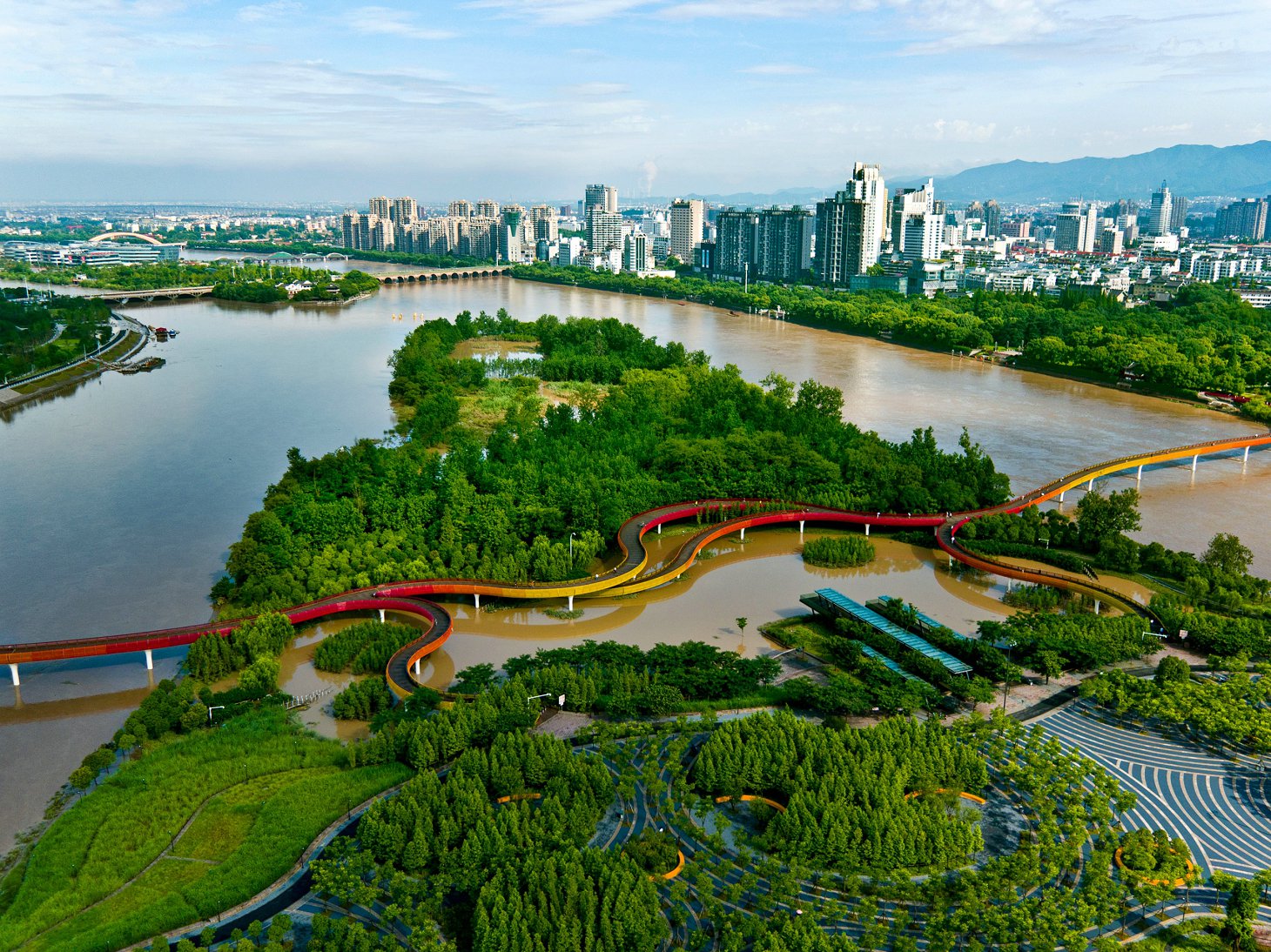
Yanweizhou Park in Jinhua City
TURENSCAPE
Since the 1700s, we’ve filled or drained as much as 87% of the world’s wetlands, which would otherwise be flexibly absorbing and releasing water. It’s a key reason urban flooding is increasing worldwide: as populations grow and cities expand, builders pave floodplains and farmland, fell forests, and channelize rivers, leaving stormwater that once filtered into the ground with nowhere to go. The land area lost to cities has doubled worldwide since 1992. When a city increases the area of roads, sidewalks, or parking lots by 1%, stormwater runoff boosts annual flood magnitude in nearby waterways by 3.3%.
In dense cities, only around 20% of rain actually infiltrates the soil. Instead, drains and pipes carry it away—lunacy, Yu thinks, in places with water shortages.
In the early 2000s, Yu and a research team created a map of Beijing showing where land was at high risk for flooding, which he called the “ecological security pattern.” His recommendation was that this land should remain undeveloped, and should be used instead to absorb stormwater.
Government officials ignored him. But then, in July 2012, disaster struck. Beijing’s largest storm in more than 60 years chucked down as much as 18 inches of rain in places, flooding roads three feet deep and filling underpasses. Yu barely made it home from work. “I was lucky,” he says. “I saw many people abandon their cars.” Almost 80 people died, most of them drowned in their vehicles, electrocuted, or crushed under collapsed buildings. The damage stretched across 5,400 square miles and cost nearly $2 billion.
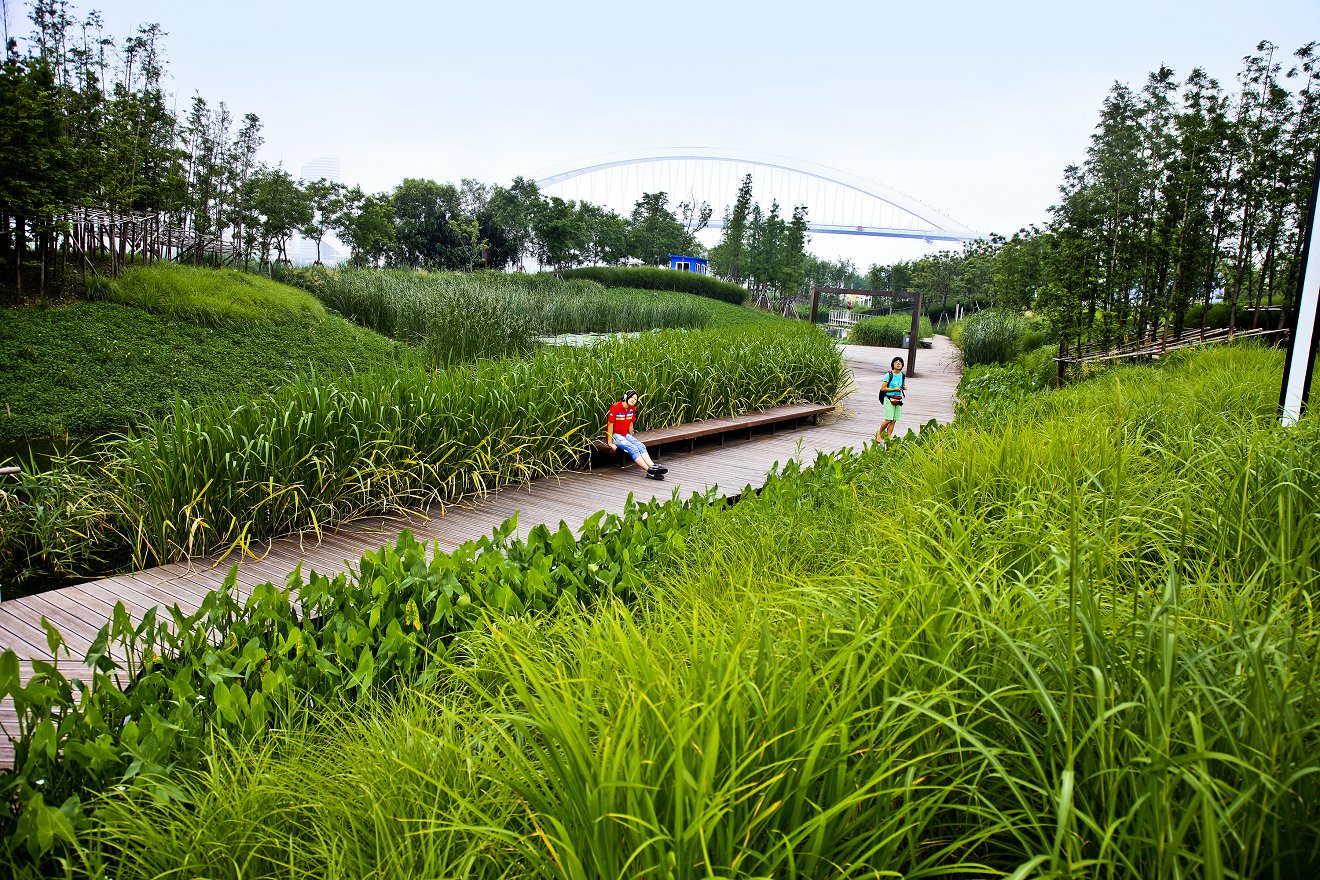
Shanghai Houtan Park
TURENSCAPE
“The 2012 flood gave us the lesson that the ecological security pattern is a life-and-death issue.” Yu says.
Climate change has worsened these threats. With every 1 °C increase, the atmosphere holds 7% more water vapor. So when clouds burst into rain, it pours. Meanwhile, dry areas get drier as the warmer air evaporates more water out of soil and plants.
Now we’re starting to see the impact on the water cycle. Summer and fall 2021 brought deadly flooding to New York, New Jersey, Tennessee, Alabama, Germany, Belgium, India, Thailand, and the Philippines. At the same time drought, crop failures, and forest fires plagued the American West, Syria, Guatemala, Greece, and Siberia. Global economic losses from flooding rose from $500 million annually, on average, in the 1980s to $76 billion in 2020. When it comes to drought, more than 2 billion people around the world already live with severe or high water insecurity. Researchers predict that as the climate continues to warm, two-thirds of the global population—more than 5.25 billion people—will experience progressively worse and more frequent drought conditions.
These recent disasters have brought home to many people the truth of what climate scientists have been saying for years: climate change is water change.
Less than a year after the 2012 storm, President Xi Jinping announced a nationwide program dubbed “sponge cities” (because a sponge absorbs water and then releases it slowly). The idea of giving water space was thus elevated from fringe concept to national mission. In 2015 the central government began demonstration projects in 16 cities, and it added 14 more in 2016. Each project covered at least five square miles, although some were larger, with the goal of retaining 70% of the average annual rainfall on site by 2020.
In November of that year, the state-controlled broadcaster China Central Television reported completion of the 30 pilot projects. It said they were preventing and mitigating urban disasters, increasing environmental benefits to waterways, and reducing water pollution. CCTV further reported that between 2016 and 2020, the sponge city concept had been implemented in 90 provincial-level cities and included in the master plans for 538 cities. A new goal aims for 100 cities with more than 1 million people to meet the 70% rainwater capture target by 2030.
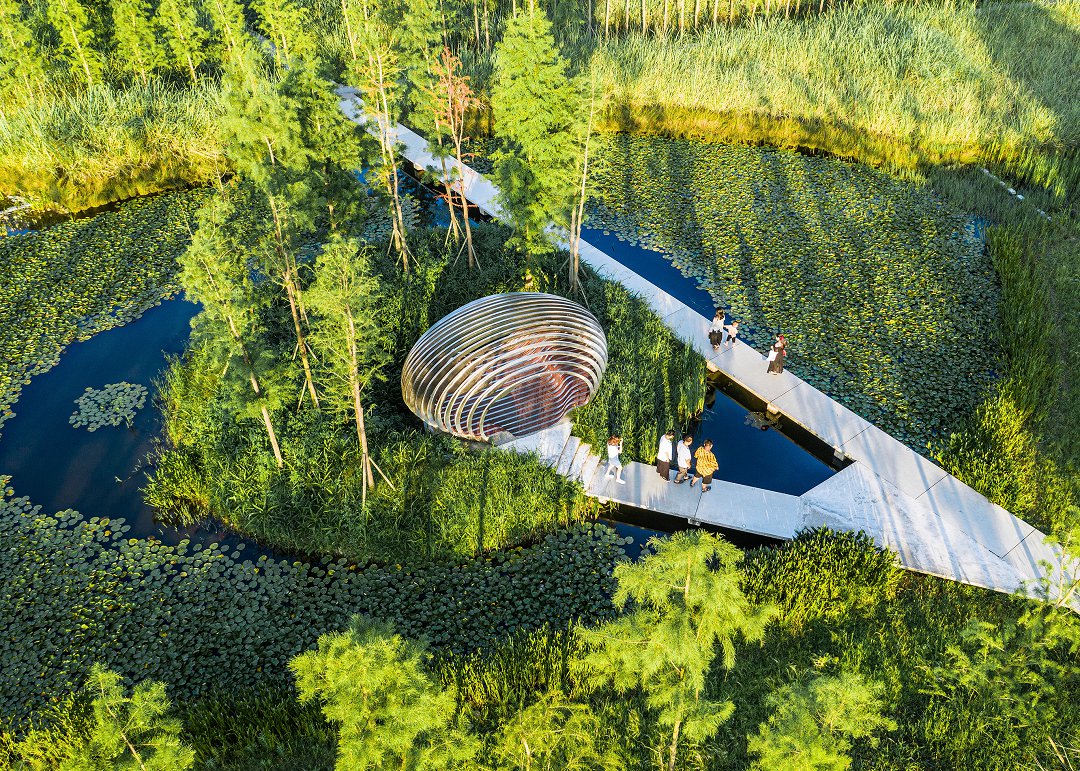
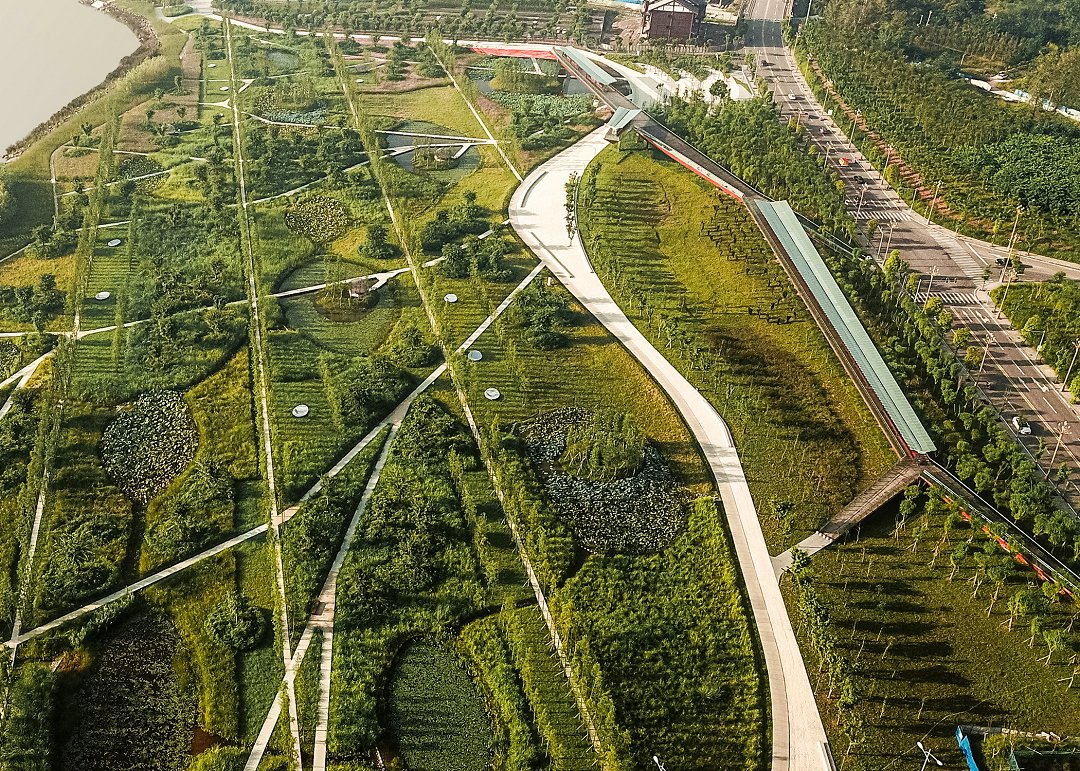
Two views of Tongnan Dafo Temple Wetland Park in Chongqing City. Below, a structure inspired by the Dafo Temple. At right, an aerial view of the park. In 2020, Chongqing faced a 100 year storm, but the landscape protected nearby farms from flooding.
TURENSCAPE
“It is, of course, a success story,” says Chris Zevenbergen, an expert in urban flood-risk management at the IHE Delft Institute for Water Education in the Netherlands and a visiting professor at China’s Southeast University. Chinese government reports are best viewed with skepticism, but Zevenbergen says he’s cautiously optimistic that the rosy assessment will be borne out.
Sponge cities are part of a worldwide movement that goes by various names: green infrastructure in Europe, low-impact development in the United States, water-sensitive urban design in Australia, natural infrastructure in Peru, nature-based solutions in Canada. In contrast to industrial management, in which people confine water with levees, channels, and asphalt and rush it off the land as quickly as possible, these newer approaches seek to restore water’s natural tendency to linger in places like wetlands and floodplains.
Yu is concerned that China may be applying a cookie-cutter approach to sponge cities: “Every patient needs a different solution.”
Because of that common thread, I’ve come to think of them collectively as the “Slow Water” movement. As in the Slow Food movement, solutions are tailored to local ecology, climate, and people. The most ambitious Slow Water projects involve conserving or restoring wetlands, river floodplains, and mountain forests, simultaneously safeguarding carbon storage and protecting homes for threatened plants and animals. But there are also small urban projects, shoehorned between buildings or in narrow corridors along streets.
In April 2018, on a day with a “very high” air pollution rating, I visited Yu at Turenscape’s headquarters in Beijing. A slim, intense man with shrewd eyes and just a bit of gray at the temples, he told me that his passion for repairing humans’ relationship with water comes from his childhood during the Mao years, spent on an agricultural commune in Zhejiang province southwest of Shanghai. The youngest of five children, he spent his days observing Chinese “peasant wisdom” for managing water, techniques that had been practiced for thousands of years. To cope with scarcity, farmers maintained little ponds and berms to help rainfall infiltrate the ground, storing it for a dry day. The seasonal creek next to his village swelled and retreated with the seasons. “For me, flood is a time of excitement because the fish come to the field, the fish come to the pond,” he said. But as the country urbanized, the Chinese abandoned that knowledge and followed the Western path. Now, he believes, they need to reclaim that ethos: “We need to make friends with flooding.”
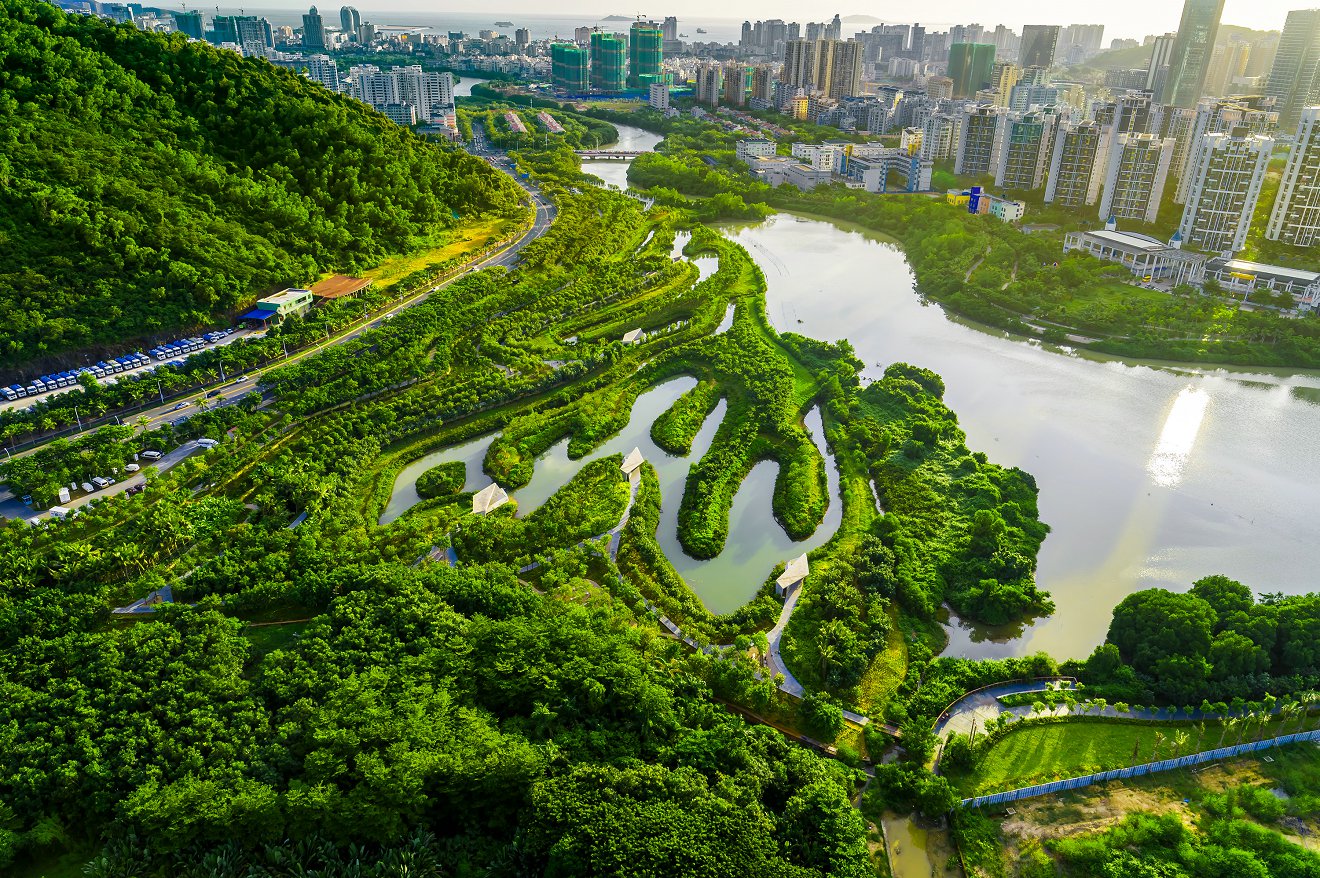
Sanya Mangrove Park
TURENSCAPE
Yu has built Turenscape into an empire, with 600 employees in three offices. The company has more than 640 projects completed or underway in 250 Chinese cities and 10 other countries. Turenscape also publishes a magazine called Landscape Architecture Frontiers, in both Chinese and English, and supports master’s and PhD candidates and postdocs who are researching hydrology or ecology, or measuring the efficacy of completed projects.
The founder and dean of the College of Architecture and Landscape at Peking University, Yu has also taught periodically at Harvard. He lectures regularly at the Ministry of Housing and Urban-Rural Development, and his 2003 book Letters to the Leaders of China: Kongjian Yu and the Future of the Chinese City is in its 13th printing. He’s been asked to consult in other countries: Mexico, for example, is hoping he can help solve Mexico City’s water problems, which are similar to Beijing’s.
When planning a project, designers first must figure out what water did before people built a city. In a large white room at Turenscape’s offices, young men and women sit at desks separated by a jungle of plants, focused intently on that question. They construct models of how water behaves within the built environment, factoring in each place’s specific ecology, geology, hydrology, and culture—a kind of computational geography. The data allows Yu and other Slow Water practitioners to model how reshaping the land and available space in various ways affects how water flows and slows.
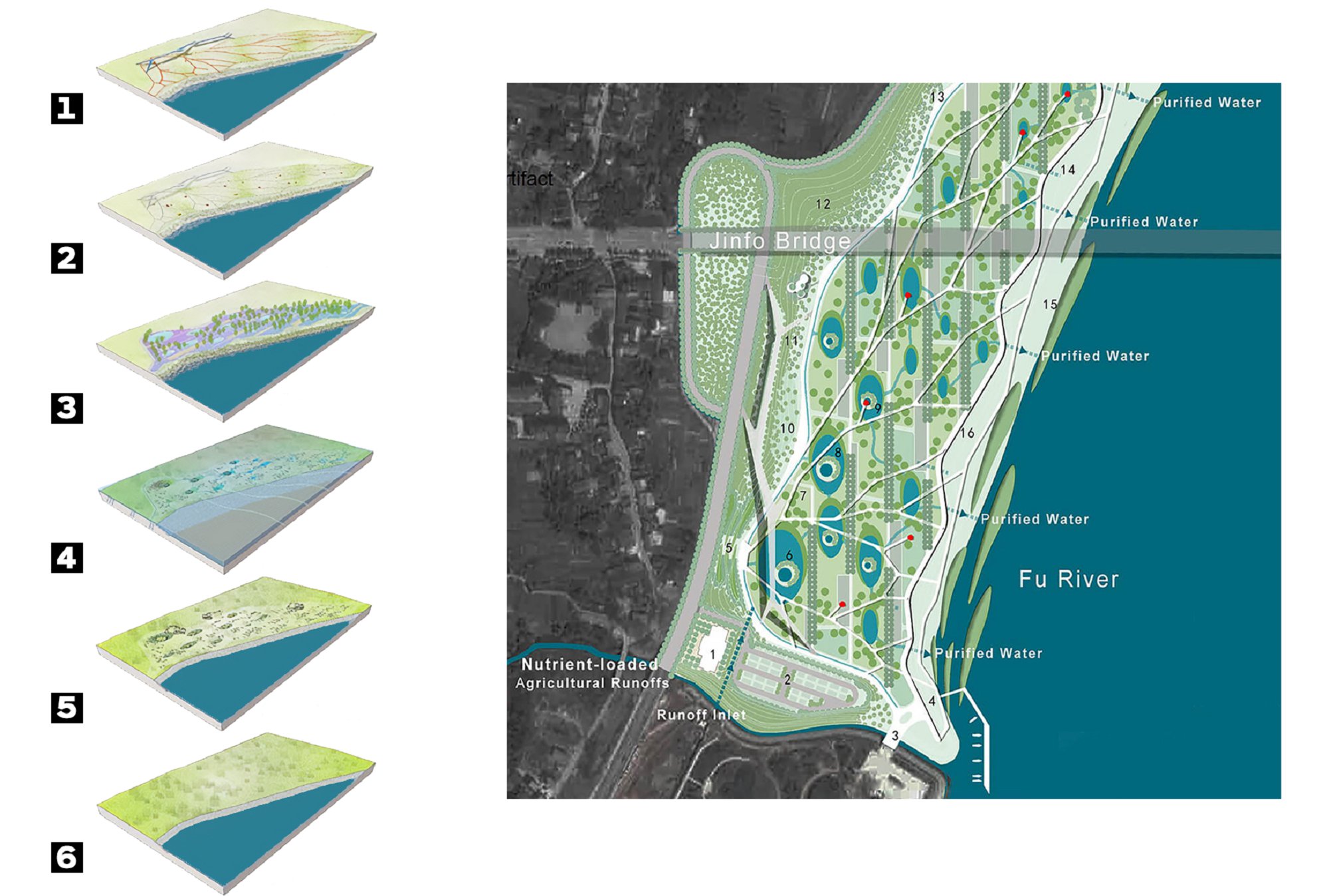
When planning a project, designers build models of how water behaves within the built environment, factoring in each place’s specific ecology, geology, hydrology, and culture—a kind of computational geography.
TURENSCAPE
Yu is now something of a hero to young landscape architects. Accompanying us to various sites was Geng Ran, an employee who exudes intense excitement to be working for him. Throughout the day, we were perpetually trotting after Yu as he rushed ahead. “He’s always like this,” said Geng, laughing.
While Yu retains his farmer’s values, he is a man of modern China. He bought and renovated a building in one of Beijing’s few remaining historic hutong neighborhoods, turning it into a private club for fellow Harvard grads, Beijing politicians, and other power brokers. This move is in keeping with his modus operandi, according to Niall Kirkwood, a professor of landscape architecture and technology at Harvard’s Graduate School of Design who has known Yu for many years. Kirkwood says Yu is a political animal, and that this—along with his vision and ambition—accounts for his success.
I got a chance to observe Yu in his natural habitat that evening. He escorted me and Geng into the club through a set of engraved metal doors and across the courtyard, where the traditional stone floor had been replaced with thick glass. Inside he ushered us downstairs to a massive table underneath that transparent floor. As we sat in ornate, carved chairs sipping bright-green cucumber juice, I looked at the moon above. Finance ministers were also visiting the club that evening, so Yu rotated between our tables. Before we left, he gave me a souvenir: a heavy tome titled Designed Ecologies: The Landscape Architecture of Kongjian Yu. After dinner, his driver chauffeured us in a brand-new Mercedes minivan to my hotel, where Yu got out to walk home—his daily constitutional.
A week later I visited one of Turenscape’s projects in progress: Yongxing River Park, located in Daxing, a far-flung exurb of Beijing. “Before” satellite pictures from three years earlier showed a river straightened and confined by steep concrete walls. “Now” pictures were chock-a-block with buildings around a more generous, meandering path for water.
The project was nearly complete when I saw it. About two and a half miles long and perhaps two city blocks wide, the park follows the river. Workers removed concrete along the river channel and excavated soil to widen the riverbed. That dirt was then molded into a large berm running down the center, creating two channels. The river flows on one side; the other channel has big holes of varying depths that act as filtration pools. During the dry season, the filtration side is filled with partially cleaned effluent from a sewage treatment plant. Wetland plants in the pools clean it further, and the slow pace allows some water to filter underground. During the monsoon season, that channel is reserved for floodwaters, and the effluent is treated industrially.
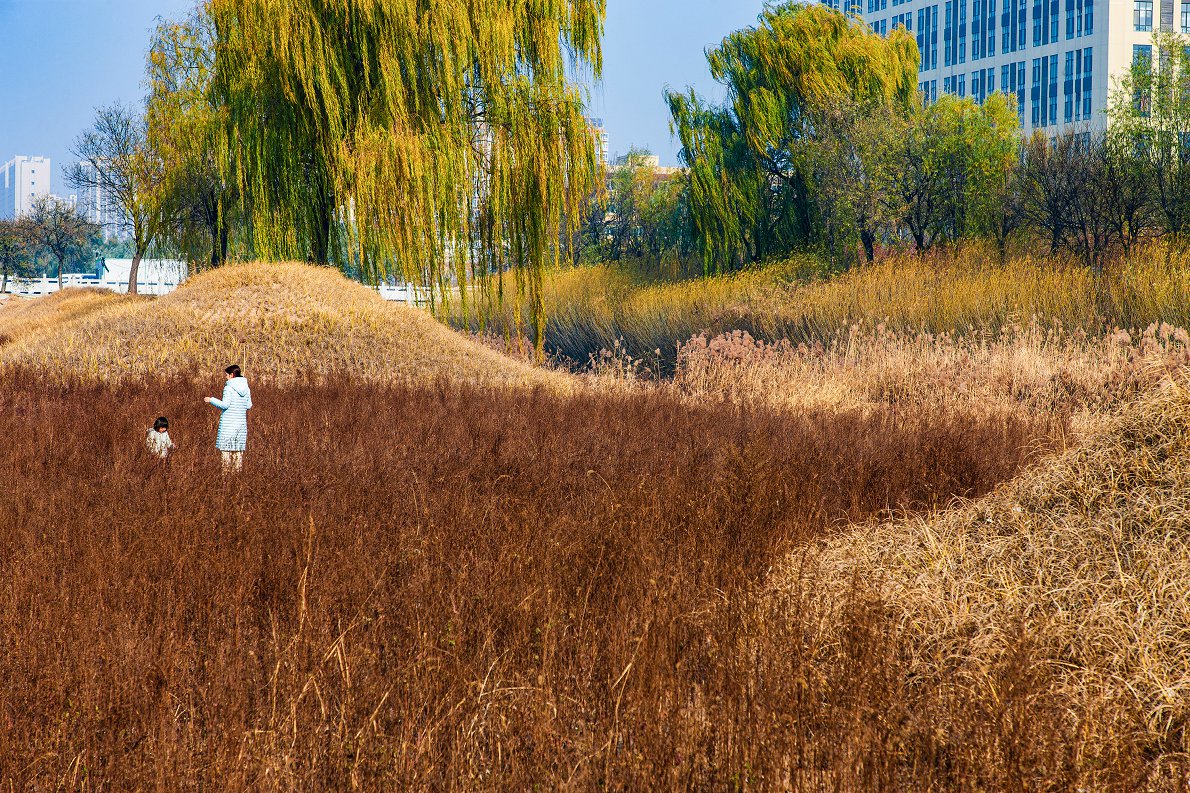
Beijing Yongxing River Greenway
TURENSCAPE
Geng and I walked a slim concrete path atop the central berm. Many of Turenscape’s designs feature walkways such as this, soaring above wetlands, so people can enter the landscape year-round and appreciate changes from season to season. The broader riverbanks, newly freed from concrete, are dotted with thousands of small sedges planted in closely set rows to hold the earth, like a pointillist-rendered landscape. We passed young willows, a native streamside plant that can survive flooding. Elsewhere, reeds, dwarf lilyturf, and other native plants stabilize the soil. Turenscape mostly uses native plants in its designs because they thrive on the water, weather, and nutrients available.
In summer 2020, during heavy summer rains, Yu sent me photos of Yongxing River Park. The trees and grasses had grown up considerably since I’d visited. The channel contained a lot of water but was nowhere close to overtopping. Turenscape does not yet have data on Yongxing’s flood capacity, infiltration rate, or water-cleaning services, but Yu called its management of that year’s monsoon a “great performance.”
It can be hard for people to conceive of making space for water in a populated area, but it’s possible. Taking advantage of space in growing exurbs like Daxing is one approach. Another is to stop building atop protective wetlands and coastal habitats—absorption capacity that is continually squandered.
Other opportunities to make space for water and reduce future losses are found even in city centers, where buildings are torn down more frequently than people assume. Disasters can also be a catalyst, such as when governments use emergency funds to buy and remove flooded buildings and convert the area to an absorbent park. Cleaned-up former industrial sites can offer up a lot of space too—often right alongside rivers. Other techniques to accommodate water in compact cities include bioswales (ditches lined with water-loving plants), infiltration ponds, rain gardens, and seepage wells. Where human space is nonnegotiable, designers sometimes use features such as permeable pavement and green roofs that can absorb water.
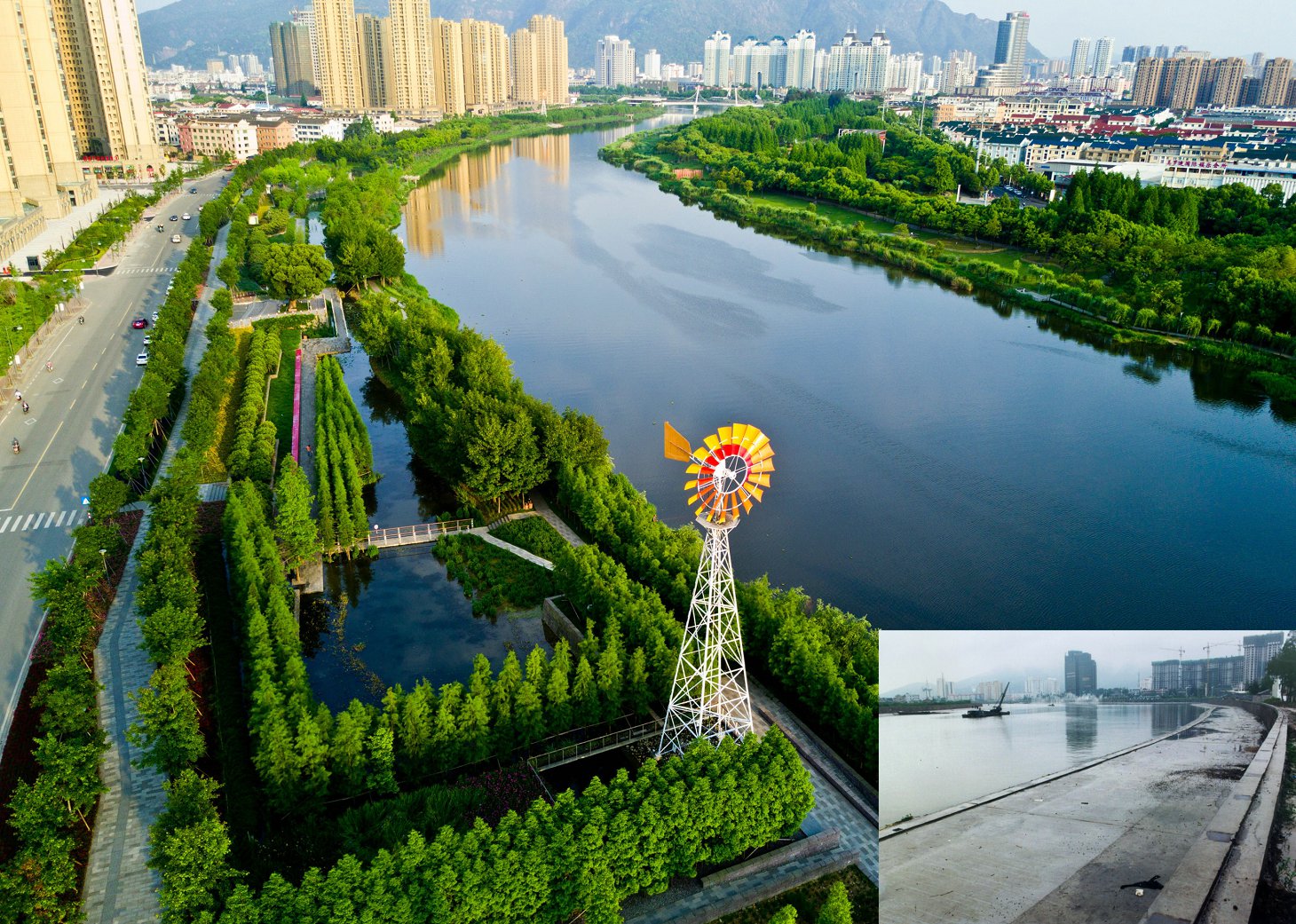
The Floating Gardens at Yongning River Park, before (inset) and after
TURENSCAPE
Yu has converted his house, a duplex he shares with his sister, into a living laboratory for some of these techniques. In the hallway are photos of his family back on the farm, Yu and his Harvard mentor, Yu with two Chinese presidents. Between the apartments, he built a living wall of porous limestone. Water captured from the roof dribbles down its face, from which maidenhair ferns and philodendrons sprout. The green wall cools the two homes enough to make air-conditioning unnecessary, although he concedes that it gets a bit warm in summer. Plants on decks off the bedrooms are watered with roof-caught rain, stored in tanks under the raised plant beds. “We collect 52 cubic meters of stormwater [annually], and I grow 32 kilograms of vegetables,” Yu says proudly. His efforts also reduce runoff from his building’s roof and decrease his personal water usage from city sources.
Though Xi’s sponge cities initiative is based on principles that mirror his own ideas, Yu fears that in some cases, China may be doing it wrong. The country has sometimes used cookie-cutter solutions for other programs, Yu says, but for sponge cities to be successful, each project must be place-specific. As Yu puts it, “Every patient needs a different solution.”
Monsoon rains across China have been heavy the last couple of summers, challenging not only standard water infrastructure, such as dams—several of which have failed or come close to it—but also the fledgling sponge cities. In summer 2021, one pilot project city with a population of around 7 million, Zhengzhou, suffered significant flooding when more than eight inches of rain fell in one hour and almost 300 people died, leading some to ask whether sponge cities were working.
Zevenbergen notes that designs may need to be tweaked to better match local needs. But the bigger factor may be that the interventions simply aren’t ambitious enough. Absorbing 70% of rainfall across five square miles of a city that spans 2,900 square miles won’t prevent flooding. Slow Water projects work best when they can absorb water across the full landscape, so planners need to think beyond the urban footprint. A city is part of a larger watershed. Restoring space for water upstream in natural river floodplains can lower the water levels downstream.
In this, too, Yu is hard at work. He’s creating a landscape master plan for all of China. At his office, he showed me a series of maps that document China’s elevation, watersheds, flood paths, biodiversity, desertification, ecological security, soil erosion, and cultural heritage. As urbanization spreads, as estuaries and deltas silt up, as water starts to move differently across landscapes and cityscapes, he identifies the spots where his projects will have the biggest impact.
Source:https://www.technologyreview.com/2021/12/21/1041318/flooding-landscape-architecture-yu-kongjian/
